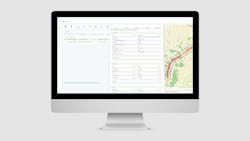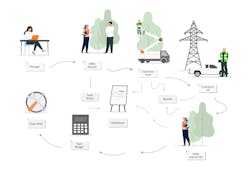Utility Technology Investments: Point-Counterpoint
Today’s utility environments are operating under increasing complexity. Once-distant innovations are rapidly coming to the forefront and ushering in an era of unprecedented collaboration among formerly siloed organizational disciplines.
With a shifting regulatory environment, increased community engagement, emerging ESG goals and a heightened focus on operational safety, effectiveness and efficiency, electric utilities are embracing tools like artificial intelligence (AI) and remote sensing more than ever before. While even the most forward-thinking utility professionals cannot accurately predict future technology requirements, key considerations—unique to each utility—can help pave a clearer path forward.
Understanding the Technology Landscape
While affordability is always a principal concern, today’s utility customers are investing in solutions that are scalable, interoperable and offer the most value to their internal and external stakeholders.
Before diving into the pros and cons of differing technology investment strategies, it’s important to provide a high-level overview of solution alternatives.
Best-of-breed often refers to the leading technology solution in a particular niche. Best-of-breed software solves a nuanced problem or serves a specific purpose. Think of tax preparation. Businesses, like consumers, often mix and match specialized technology offerings to ensure they are using the best tools to get the job done.
Best-in-class solutions typically optimize a function or series of related functions. For example, online banking or human resources information systems manage onboarding, payroll, benefits and more. Best-in-class solutions within a department or business function are highly integrated, efficient and provide a single-view of information for business intelligence.
All-in-one solutions are unified, large-scale platforms encompassing all the critical data and functionality across an organization. Examples include enterprise resource planning systems for financial management, supply chain management, inventory management and more. All-in-one solutions offer bolt-on modules for additional functionality under a single platform.
When it comes to vegetation management technology, it can be useful to frame considerations across these broad alternatives.
- Best-of-breed: dedicated work planning or arborist tools or LiDAR/satellite data processing and analytics.
- Best-in-class: vegetation work management solutions with field operations maps and workflows spanning supervisors, field crews and leadership.
- All-in-one: enterprise work management systems.
But which alternative is right for you? Will you lose flexibility if you build a wide range of functions into a single vendor platform? Will you lose speed and efficiency or add complexity by integrating different software platforms?
Evaluating Technology Investments
It can be daunting for functional managers, who may not be technology experts, to evaluate solutions in today’s fast-moving and highly competitive environment. To determine what is right for your organization and avoid a costly pilot or risk a failed implementation, you must first explore how work is done, who is impacted and how key decisions are made. Here are some key factors to consider during this process.
Identify the critical challenge you are trying to solve. A counterpart at a nationwide healthcare organization once joked, “We get more accomplished in one year than others can in a week.” Unfortunately, many of us can relate. When it comes to large-scale technology implementations, unending change requests can lead to scope creep and missed completion dates. Much of this can be circumvented through stronger front-end planning and prioritization.
Agreeing that we need to increase operational or field efficiency is not enough. In vegetation management, that may mean shortening the cycle time between audit and close or streamlining crew workflows to reduce customer response times.
It is important for the solution to be designed and built for how a utility will be using it (i.e., not adapted from another use case). Accordingly, when gathering user requirements, it’s wise to determine how well versed a potential partner is in understanding similar work environments from a variety of vantage points and solving related challenges.
Determine how broad the use cases are. Gone are the days when vegetation management departments were a stand-alone function. From investor-owned utilities to smaller cooperatives and municipalities, many departments within an organization must exchange data.
Beyond vegetation management, one of the first steps in scoping technology requirements is to gather input from each of the relevant user groups within an organization.
- Vegetation management may need solutions for work planning, scheduling, dispatching and auditing.
- Customer care may seek solutions for processing customer tickets or managing different notification requirements across operating regions or companies.
- Billing and contractor management teams may need production data by vendor.
- Finance may need a record of expenses.
- Environmental management and legal teams may seek compliance with endangered species management and habitat preservation.
- Fleet and ESG teams may want quantifiable emissions reduction data.
- Investor relations may be looking for proven data on how the utility is achieving sustainability goals and serving as good corporate citizens.
Asking the Right Questions
Gathering broad-based requirements allows utilities to begin asking incremental questions of the users and their processes to determine what elements can and should be managed in the same system. Deeper dive questions may look like the following:
- Does it make sense to use field operations software to capture environmental data or denote pollinator habitats?
- Would a single platform make sense for work planners, crews and auditors or for rapid dispatch of customer ticketing and notification of rework from auditing?
- Are contractor timesheets needed in the system? Why or why not? If yes, do they need to tie to work completion?
- Is your utility embracing remote sensing/AI solutions but still needing to support manual field processes?
Because every environment is unique, these questions don’t have one right answer. Framing and answering these types of questions with work groups allows utilities to design a solution that supports not only the necessary requirements but also other important data elements when and where they make sense. This also enables companies to determine where to draw the line.
Identify the key functional users. When weighing the pros and cons of implementing best-of-breed solutions versus best-in-class or all-in-one technology, it’s important to consider the key functional users of each element of the solution set. If shared, a consistent user experience is a worthwhile investment. Utilities can lose millions per year in lost field productivity due to poor usability at the additional cost of employee and contractor morale.
Diagramming the collaborative processes across the organization is recommended to provide a unified view, remove fragmentation and silos and ensure critical data flows freely across teams.
Figure out what decisions will be made with the data and how quickly they will be made. In general, day-to-day work management processes require more granularity of data than, for example, the data rollup required for a monthly financial close. During your discovery process, it’s critical to determine the level of detail required by each decision maker, and associated timing, and use that as a guide to design the optimal system.
Stay Updated on Technological Advances
Before building a complex, real-time, front-end system for native integration to your enterprise work management system, determine if a simple integration of relevant information, without custom coding, is doable, effective and efficient. You must also understand the maturity or fast-moving nature of the technology. Innovation is driving the world, and utility technologies are no exception. For example, consider the impact of cybersecurity, mobile operating systems and mobile device management in the industry.
Technology built years ago is no longer supported and/or needs to be rewritten. Pay attention to how well any commercial vendor is staying current with the underlying technology and how much custom code for your organization is being built upon it. Staying up-to-date and maintaining compliance with custom solutions in fast-moving technologies can become a challenge.
In addition, some technologies such as AI, machine learning and even remote sensing are in their infancy. Tying your company to a specific technology at an early stage while another model may prove to be superior longer term may be detrimental.
Consider how rapidly data acquisition is changing with LiDAR and satellites. Also think about how quickly remote sensing and machine learning models are extracting intelligence regarding clearance, tree species, tree health and more. Also ask yourself how quickly, if ever, these will become the primary tools for planned maintenance work or managing customer tickets, notifications and capturing customer interactions. An important balance is in play today with sky-based programmatic innovations and ground-based customer experience strategies that should not be overlooked.
The best companies in the field are innovating rapidly. The key to success is parsing out what elements of the proposed solution are already becoming commoditized (such as data acquisition) versus those that are continuing to innovate (such as image processing and data intelligence). Next you must ensure you establish clarity around what that means to your organization's ability to manage the technology over time.
Finding the Best Fit
When doing research, you must also consider a vendor’s area of expertise. While many solution providers are building the business of tomorrow today and technology convergence is on the rise, their foundational strengths and depth of industry knowledge are likely to differ (e.g., remote sensing, satellite imaging, data analytics and technology integration).
Odds are in your favor that each provider will readily maintain its areas of expertise. But what innovative approaches or new frontiers might your vendor miss if it is looking through a single lens? Take the time to analyze each vendor and discuss, with your larger discovery team, what foundational strengths are critical to your success longer term. Center your approach upon these strengths. In addition, investigate each potential partner’s pilot success rates and longer-term technology adoption. These are critical inputs to help you assess technology sustainability and potential maintenance requirements over time.
For example, placing a best-in-breed remote sensing bet may pave the way for innovation with a partner of choice for some utilities. For others, a configurable, best-in-class vegetation management platform incorporating remote sensing data from a range of providers provides the longer-term flexibility they need.
You must also evaluate the level of burden on your utility’s IT resources. In today’s utility environment, a heavy emphasis is placed on data- and cybersecurity. Couple that with system integrations, upgrades, optimizing for interoperability and managing too many tools in a tech stack can lead to administrative nightmares and skyrocketing costs.
At many utilities, changes to large enterprise systems are frowned upon due not only to expense considerations but also potential adverse impacts on other key functions these systems support (e.g., inventory and financial reporting). Building custom, front-end applications for enterprise asset/work management systems may tie the hands of a vegetation management department looking to innovate its business processes. Reducing complexity by thinking through the long-term administrative burden upfront is mandatory.
Implementing the right technology solution to meet your specific needs requires a host of in-depth considerations and planning—especially since the range of options has grown substantially in the past few years with no signs of slowing down. It takes significant effort to answer these fundamental questions and discover the ideal boundaries for the range of systems and software that can deliver value to your utility vegetation management programs.
Chris Kelly ([email protected]) is co-founder and CEO of Clearion.
About the Author
Chris Kelly
Chris Kelly is the CEO of Clearion.




